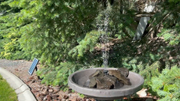
Have you ever wondered if there was an eco-friendlier way to run a garden fountain or small pond, or even an irrigation system without the burden of monthly electricity bills? Today, homeowners and garden enthusiasts alike are embarking on a green revolution in place of traditional power-hungry devices with solar-powered solutions. One such option is the Poposoap solar-powered water pump, which promises zero direct electricity costs and minimal carbon emissions. This article will look at how solar pumps are compared to conventional electric models, go through real case studies in terms of quantifying energy-saving benefits, and revisit why making a switch can be one of the smartest and greenest choices for your home or garden.
Why Solar-Powered Water Pumps Are Becoming Increasingly Popular

1.No Electricity Costs
The major advantage a solar-powered water pump has is that it draws its power from the sun rather than from an electrical grid. This essentially erases ongoing power charges so the homeowner can experience constant water movement without additional cost every month. Over time, this can amount to a great deal for those who have a fountain or other water feature running daily.
2.Low Maintenance, High Reliability
Thanks to advances in solar panel technology, solar pumps are more reliable today than they have ever been. Many have simple plug-and-play designs featuring few moving parts and minimal wiring. This often equates to lower maintenance demands-a plus for anyone looking to avoid hassles. In addition, you've got the peace of mind of knowing you aren't restricted to having to stay near a power outlet or concern yourself with power outages.
3.Eco-Friendly and Sustainable
Unlike electric pumps, which draw their power from fossil-fuel-derived energy, a solar-powered water pump produces very minimal or no greenhouse gas emissions during its operational time. You are reducing your carbon footprint by tapping into clean, renewable sunlight. In an increasingly climate-conscious world, this small step can go a long way toward wider environmental goals.
The Advantages Over Traditional Electric Pumps
1.Eliminating Standby Power Loss
Most traditional electric pumps stay plugged in all day and night, though they may only work at intervals. That can waste "vampire power" just from being hooked up. A Poposoap solar powered water pump, on the other hand, only operates if adequate sunlight hits the panel—there's no need for it ever to go into a standby mode to waste electricity.
2.Flexible Positioning
Electric pumps need an outlet, which sometimes confines you to certain places in your yard. Long extension cords are unattractive, unsafe, or both. For greater flexibility in where you situate your fountain or water basin, you opt for a solar pump. Just the solar panel needs to capture enough direct sunlight, so positioning can be everywhere. It can make beautiful layouts in the gardens without the limitations of electricity, for example.
Practical Tips to Maximize Solar Pump Efficiency

1.Optimal Placement of the Panels
It needs to be seen that your water pump's solar panel receives a minimum of six hours of direct sunlight every day for maximum output. Consider also the path that the sun has during different months. Usually, the best output throughout the entire year is usually at a tilt angle equal to your latitude.
2.Cleaning and Regular Maintenance
It loses 15% or more in efficiency when it collects dust, dirt, or bird droppings on top of the panel. A gentle wipe with a soft cloth once every few weeks, or when particularly dusty/dry or wet periods occur, keeps it working at an optimum. Also, periodic checking on the intake side of the pump will help keep it from being clogged due to leaves, algae, and sediment.
3.Freezing Temperatures Protection
In cold climates, the water can freeze around the pump and damage parts. If you live in an area with very cold weather, consider draining the system or relocating the pump indoors during such spells. Small pond heaters, or winter-proof designs, can be an alternative for some owners, but they might somewhat balance out the advantage of zero electricity if the heaters are grid-fed.
4.Battery and Backup Solutions
Although the majority of conventional solar pumps cannot function in low sunlight, new designs may offer either integrated batteries or external storage devices. Such options allow for operation when overcast conditions prevail or during nighttime hours. The addition of a battery increases initial costs but increases use and reliability for customers seeking uninterrupted water flow.
Real-Life Success Story

Julie, a homewardener from California, replaced her electric 50W pond pump with the Poposoap solar powered water pump to circulate a small fishpond. Though concerned with consistency of power, she found that ample sunlight in her region provided more than adequate daily runtime. In one year, she estimated she saved approximately $25 in electricity. More importantly, she liked how the solar pump fit right into the ecosystem of her pond: clear water, healthy fish, and reduced algae. "I never realized how much time I was spending worrying about the cords and outlets," she says. "Now I just wake up, let the sun do its job, and listen to running water."
Conclusion
Solar technology is also developing at a blistering pace, evolving from lab experiments to user-friendly everyday devices. Case in point is the Poposoap solar water pump: the world's first solar-powered water pump. Solar water pumps cut electricity bills, greenhouse gas emissions, and, just as importantly, offer worry-free operation—a prospect that's equally attractive to penny-pinchers and green-conscious homeowners.
From tiny birdbaths to medium-sized garden ponds, these pumps get around. Throw in competitive pricing on solar panels and simplicity of installation, and it's little wonder that so many are making the switch. A single pump may not cut utility bills dramatically, but as a move in the direction of sustainability, it stands to save money, minimize environmental impact, and offer the joy of birds and fish thriving in a sun-powered ecosystem.







